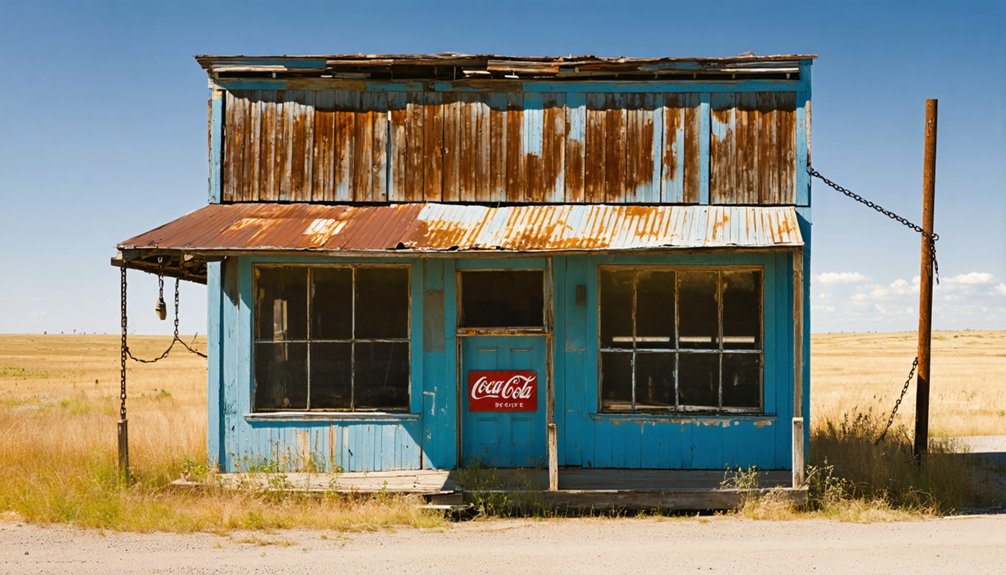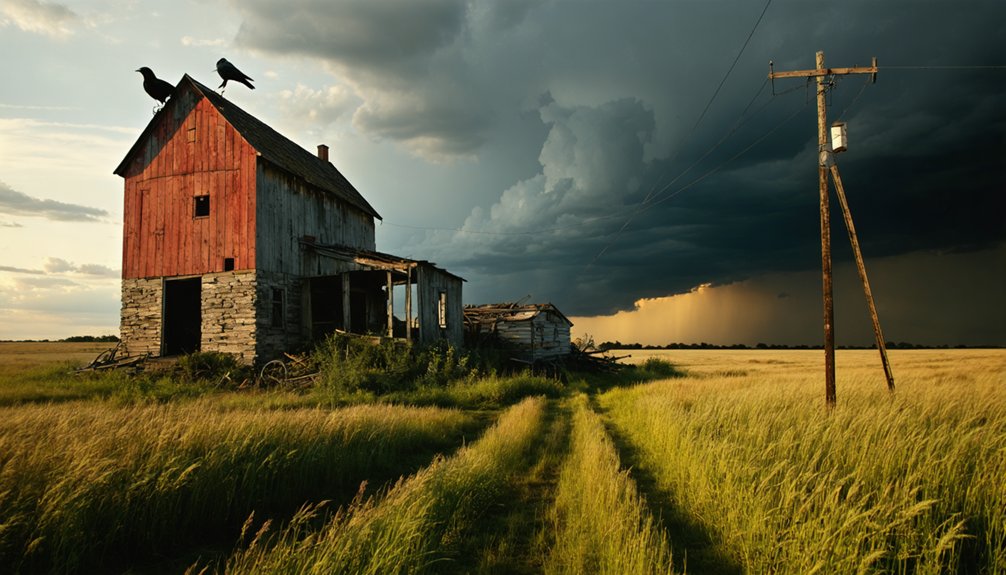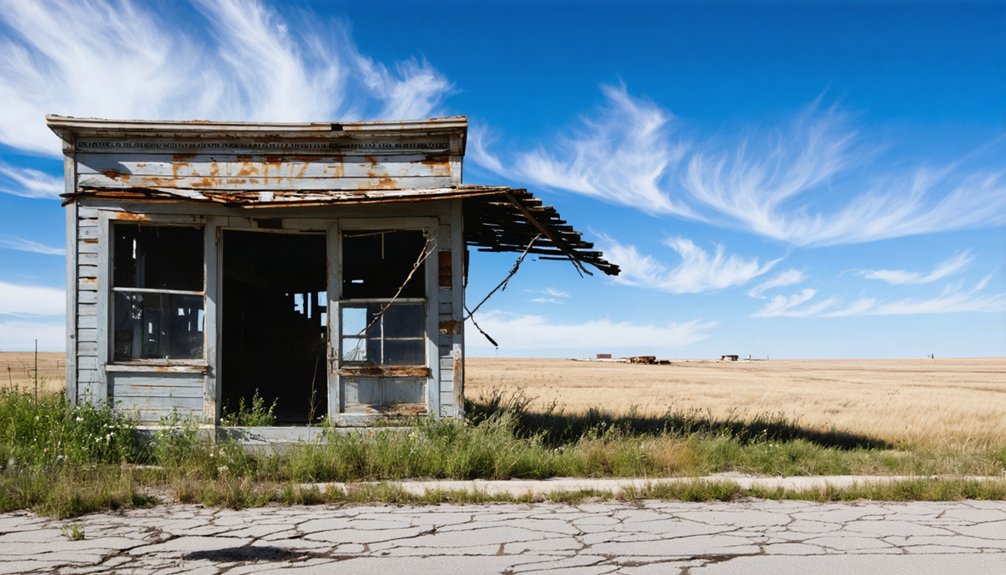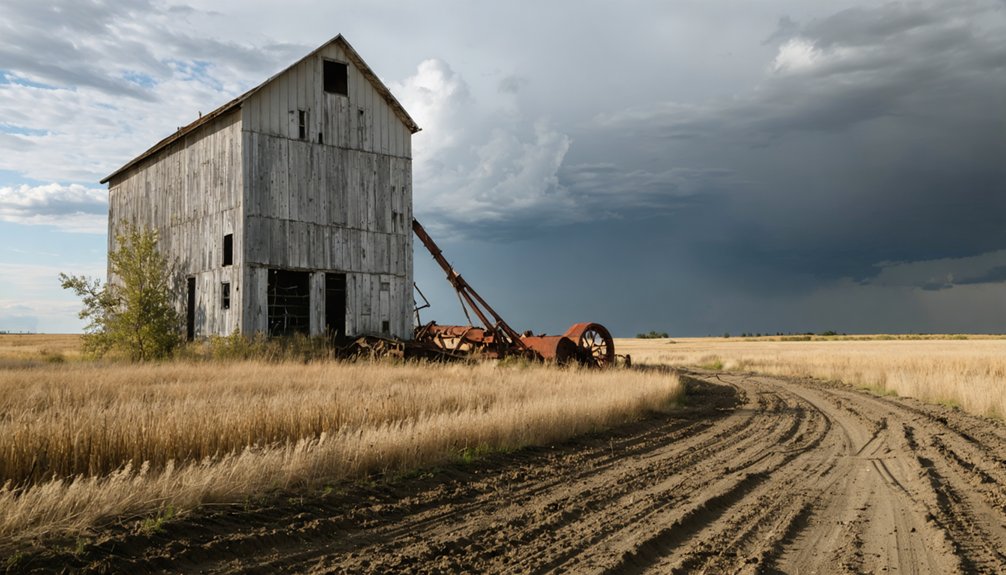Postville emerged along South Dakota’s railroad expansion in the 1880s, thriving as an agricultural hub with grain elevators and merchant shops. You’ll find its history marked by the harsh realities of frontier life, from buffalo chip fires to brutal blizzards. The town’s decline began with the 1950s shift to truck transportation, and its fate was sealed by a devastating 2003 tornado that caused $13.5 million in regional damage. The remnants of this once-bustling prairie settlement hold countless untold stories of frontier perseverance.
Key Takeaways
- Postville was established as a railroad town in South Dakota during the 1880s boom, becoming an agricultural hub along strategic rail lines.
- The town featured a T-shaped layout with a commercial avenue perpendicular to railroad tracks and thrived through rail-based commerce.
- Economic decline began in the 1950s when truck transportation routes bypassed Postville, leading to loss of business and population.
- The disappearance of railroad services by 1969 severely isolated the community, with over 60% of regional rail networks lost by 1980.
- A devastating tornado in 2003 caused significant damage to Postville’s remaining structures, marking the final event that led to abandonment.
The Birth of a Prairie Railroad Town
While railroad expansion swept across South Dakota in the 1880s, fierce competition among entrepreneurs and towns shaped the region’s development through strategic route planning.
You’d witness an intense railroad competition where settlements’ very survival hung on the whims of railway companies. Every 7-10 miles, these iron giants would establish new towns along their tracks, transforming the prairie landscape into a network of bustling commercial hubs.
Similar to the arrival of the McGregor and Western Railroad in 1864 that transformed Postville’s economy, railroad companies wielded immense influence over town development. When the Milwaukee Road announced its 1886 route, bypassing existing settlements, you’d see entire communities uprooting themselves to follow the rails. The railroad’s power was absolute – they’d name towns after their officials, plat new communities on their terms, and orchestrate mass town relocations. Towns like Dakota City watched their businesses and residents migrate to Parkston’s thriving community, leaving once-promising settlements to fade into obscurity.
Life in Early Postville
Early settlers arriving in Postville faced stark challenges that would test even the hardiest pioneers. You’d find yourself struggling daily with scarce water and wood, forcing adaptations like using buffalo chips for fuel. Your survival meant digging wells, battling prairie fires, and enduring brutal blizzards that could leave you isolated for weeks. The region’s harsh continental climate conditions brought extreme temperature swings throughout the year.
Despite these settler struggles, you’d witness remarkable community resilience. The Post family hosted Postville’s first social gathering on New Year’s Day 1849, beginning a tradition of mutual support. Early homesteaders established trading posts to barter with local tribes and other settlers, following the model that dominated the 1830s economy.
You’d find comfort in gathering at local taverns like the “Half-Way House” and post offices, where scattered neighbors could connect. Working together through organizations like the Grange, you’d share farming techniques, often adapting Native American methods for cultivating the tough prairie soil under your Homestead Act claim.
Transportation’s Impact on Growth
You’ll find that Postville’s early growth followed a familiar pattern of railroad-driven settlement, with the arrival of rail service in the late 1800s transforming it from an isolated outpost into a bustling agricultural hub.
The town’s strategic location along the rail line attracted grain elevators, warehouses, and merchants, while farmers relied on the railway to ship their harvests to distant markets.
Like many South Dakota communities during this era, Postville adopted a T-shape layout with its main commercial avenue running perpendicular to the railroad tracks.
Railroad Drives Settlement Growth
Once the railroads arrived in South Dakota in 1878, they triggered an unprecedented wave of settlement known as the Great Dakota Boom.
Railroad expansion transformed the territory as companies actively recruited homesteaders through aggressive land advertising campaigns. You’d find new towns emerging every 7-10 miles along the tracks, carefully positioned by railroad surveyors to maximize economic opportunities.
The impact was particularly dramatic east of the Missouri River, where settlements grew dense by 1887.
Towns lived or died by the railroad’s path – those bypassed often disappeared, while others, like Parkston, physically relocated to align with the tracks. The depot became each community’s lifeline, handling everything from mail to grain shipments.
Railroad access meant reliable transportation of essential supplies and profitable market connections for farmers’ crops.
Truck Traffic Changes Everything
The rise of truck transportation in the 1950s marked a dramatic change from Postville’s railroad-dependent past. As South Dakota’s highways expanded, new truck routes bypassed the town’s traditional rail-based freight dynamics, fundamentally altering its economic landscape.
You’ll find that this change hit Postville particularly hard. The town’s infrastructure, designed for rail commerce, struggled to adapt to heavy truck traffic. Local businesses, once thriving on railroad connections, faced declining relevance as trucking favored better-connected communities.
While some South Dakota towns successfully transformed into truck-friendly hubs with warehousing and distribution centers, Postville couldn’t compete. Like many regional restrictions affecting growth, the town’s geographic isolation limited its ability to adapt.
The environmental and social costs mounted too. Increased truck traffic brought noise pollution and road wear, while the community watched its railroad-era prosperity fade. This change in transportation ultimately accelerated Postville’s descent into ghost town status.
Isolation Leads to Decline
While railroads initially fueled Postville’s growth before 1920, their gradual disappearance left the town increasingly cut off from essential economic connections.
You’d have seen how post-WWII transportation policies favored highways over rail maintenance, forcing many rail lines to close. By 1969, passenger services had completely vanished, and by 1980, South Dakota had lost over 60% of its rail network.
The impact on Postville’s community resilience was devastating – without reliable rail transport, shipping costs soared and commercial opportunities dwindled. The aging infrastructure, built before 1920, couldn’t handle modern freight demands, and the town’s isolation deepened. Many of these century-old rail lines still exist today, with components dating back to 1908 and 1929, posing significant safety risks.
While trucks offered some flexibility, they couldn’t match rail’s efficiency for bulk agricultural goods, accelerating Postville’s economic decline and population loss.
Daily Commerce and Community

You’d find Postville’s general store at the heart of daily commerce, stocking essential supplies transported by rail from larger distribution centers to meet the farming community‘s needs.
Similar to how Philip O’Connor would share stories about his town’s heritage, locals gathered to exchange tales of Postville’s early days and development. The town’s social fabric was woven through gathering spots like the local saloons, barbershops, and church, where residents exchanged news and conducted informal business transactions. Like many towns during the Dirty Thirties, Postville faced significant economic challenges that impacted local businesses and community life.
Local enterprises, from grain elevators to the hardware store, operated in sync with agricultural seasons, providing critical services to support the region’s farming operations.
Store Supply Networks
Supply chains formed the lifeblood of Postville’s commercial ecosystem, with general stores operating through established networks of trust and efficiency. You’d find supplier relationships built on open accounts and handshake agreements, reflecting the close-knit nature of business dealings.
Store partners divided merchandise management by department, ensuring ideal inventory control across product lines. Railroads played an essential role in your store’s supply network, with regular shipments arriving via the depot. You’d receive grocery items biweekly, while fresh produce came weekly from regional hubs like Minneapolis in refrigerated railcars.
Seasonal buying cycles dictated when you’d stock up on textiles and shoes. The South Dakota Retailers Association strengthened these networks, helping you coordinate buying methods and protect local merchant interests against distant catalog houses. The standard three dollar membership granted access to valuable business connections across the state.
Social Meeting Places
Three primary venues shaped Postville’s social landscape during its heyday: the general store, post office, and railroad depot.
You’d find residents gathering daily at these hubs, exchanging news and strengthening community bonds while conducting essential business. The general store served as an informal community center where you could purchase supplies while catching up with neighbors.
At the post office, daily mail operations created natural opportunities for social networks to form through regular interactions.
This vibrant social fabric began unraveling as transportation shifted from rail to trucking, gradually isolating the town.
The devastating 2003 tornado delivered the final blow, destroying the physical spaces where community interaction had flourished.
Today, these once-bustling meeting places exist only in memory, their ruins evidence of Postville’s vanished social life.
Local Business Operations
Due to the lack of verifiable historical records about Postville’s business operations, an extensive discussion of its daily commerce and community activities can’t be accurately presented.
While you’ll find numerous accounts of ghost towns scattered throughout South Dakota’s Black Hills region, specific details about Postville’s local economy remain undocumented in current historical datasets.
The pattern of business decline that affected many small frontier communities in South Dakota likely impacted Postville as well, but making specific claims about its commercial activities, merchants, or trading patterns would require additional research through county records and regional archives.
If you’re interested in learning more about Postville’s business operations, you’ll need to consult local historical societies, period newspapers, or other primary sources that might contain information about this particular settlement.
The Winds of Change

While many South Dakota towns sprang up around railroad development in the late 1800s, Postville’s story began with a simple post office serving remote ranchers.
The community’s resilience would soon be tested as major changes swept through the region. Historical preservation efforts help us understand how transportation shifts impacted Postville’s fate.
These key developments transformed the town:
- The rise of automobiles and trucks in the early 20th century reduced dependence on rail services.
- Improved road networks allowed travelers and freight to bypass smaller communities.
- Young residents began migrating to larger cities for better opportunities.
As rail service declined, local businesses struggled to survive.
Without the steady flow of rail traffic and with a shrinking population, Postville’s economic foundation gradually eroded, leading to its eventual abandonment.
Nature’s Final Blow: The 2003 Tornado
On June 24, 2003, a devastating tornado outbreak struck eastern South Dakota, delivering what would become Postville’s final blow.
You wouldn’t have stood a chance against the 67 tornadoes that touched down that day, including powerful F4 twisters that ravaged the region. The storm’s multivortex characteristics created an unprecedented path of destruction.
In the tornado aftermath, Postville’s remaining structures didn’t fare well among the $13.5 million in damages across the region.
The community recovery efforts proved too overwhelming for the tiny town, as insurance claims mounted and federal assistance couldn’t restore what was lost.
Facing insurmountable losses and limited aid, the small town couldn’t muster enough resources to rebuild their shattered community.
While larger communities in eastern South Dakota rebuilt, Postville’s dwindling population saw this natural disaster as the sign they’d been dreading – it was time to leave for good.
What Remains Today

Today, wandering through Postville reveals a haunting collection of deteriorating structures that stand as silent witnesses to the town’s former life.
You’ll find abandoned structures scattered across the prairie landscape, where nature steadily reclaims what humans left behind.
While exploring this forgotten settlement, you’ll discover:
- Several original buildings still standing, though most lack roofs and are crumbling
- Rusted vehicles and equipment remnants that hint at daily life from decades past
- Building foundations and debris piles marking where homes and businesses once thrived
Though attempts to transform Postville into a living ghost town museum failed, you can still freely explore the site.
Historical artifacts are scarce, and without markers or plaques, you’ll need to rely on research to understand the stories these weathered remains tell.
Legacy of a Lost Settlement
As a proof of early 20th-century rural development in South Dakota, Postville’s legacy endures through its physical remains and historical significance.
You’ll find its cultural significance deeply rooted in the region’s rural heritage, where it once served as a crucial hub for local ranchers and farmers needing postal services and basic supplies.
The town’s story mirrors countless other ghost towns across South Dakota, where changing transportation patterns and economic shifts led to decline.
When a devastating tornado struck in 2003, it destroyed much of what remained, accelerating Postville’s shift to ghost town status.
Yet, you can still trace the town’s importance in South Dakota’s development through its ruins, which stand as silent witnesses to the challenges faced by early settlers and the evolution of rural communities.
Frequently Asked Questions
Were Any Notable Crimes or Murders Reported in Postville’s History?
You won’t find documented murders within Postville itself, though local legends hint at unsolved mysteries. The closest confirmed violent crime was the Mathis murders near Mount Vernon in 1981.
What Native American Tribes Originally Inhabited the Area Before Postville’s Establishment?
You’ll find that Western Dakota (Yankton/Yanktonai) Sioux tribes originally claimed this territory, while the broader region’s Lakota heritage extends back generations before European settlement transformed the landscape.
Did Any Famous People Ever Visit or Live in Postville?
You won’t find any famous visitors or historical figures connected to this place – no documented evidence exists of celebrities ever living in or passing through this rural post office stop.
What Was the Highest Recorded Population of Postville?
Like footprints in shifting sand, Postville’s highest population remains elusive in historical records. You won’t find exact numbers, though county data suggests the town’s peak likely didn’t exceed several hundred residents.
Were There Any Active Mining Operations Near Postville?
Yes, you’ll find coal mining was prominent near Postville’s ghost town location. The Firesteel Coal Company operated from 1923, producing over 53,000 tons in 1942, following earlier mining history started by Traversie in 1907.
References
- https://www.youtube.com/watch?v=Glucs_Rq8Xs
- https://www.sdpb.org/rural-life-and-history/2023-08-21/some-black-hills-ghost-towns-and-their-origins
- https://www.powderhouselodge.com/black-hills-attractions/fun-attractions/ghost-towns-of-western-south-dakota/
- https://www.sdhspress.com/journal/south-dakota-history-2-2/some-black-hills-ghost-towns-and-their-origins/vol-02-no-2-some-black-hills-ghost-towns-and-their-origins.pdf
- https://www.youtube.com/watch?v=_0WNYsFLSLA
- https://icatchshadows.com/okaton-and-cottonwood-a-photographic-visit-to-two-south-dakota-ghost-towns/
- https://en.wikipedia.org/wiki/List_of_ghost_towns_in_South_Dakota
- https://b1027.com/south-dakota-has-an-abundance-of-ghost-towns/
- https://www.ammhistory.com/The-Railroad-Part-1
- https://www.cityofpostville.com/history



